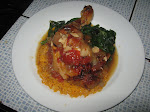The household foraging began a couple of days ago when I pulled a ball of pizza dough from the vast and icy deep and made a pizza with homemade sausage, garden onions out of the storage shed and tomatoes we had dried ourselves. Kathy had made a small provisions run when we heard the snow was coming and we had a nice combination of cheeses to make the pizza really sing.
Yesterday was chicken stock day and the house was filled with the aroma of nicely roasted bones simmering with their attendant and complimentary vegetables and the house still has that roasty rich smell hiding in different corners and down the back hallways. I've always contended that, rather than the"smell of chocolate chip cookies baking" theory that realtors proscribe to for selling homes, that the "aroma of homemade chicken stock" would work even better.
While the stock hoozled and goozled happily yesterday morning we went to the freezer yet again looking for food to feed unexpected lunch guests. Kathy's daughter, son in law and granddaughter made the trek up the hill to visit us, (but mostly to play in the snow) and we needed a cold day meal for them. We went deep into the freezer and came up a container each of chile and a multi-bean soup, made long ago, and along with some homemade biscuits we had just the meal for hungry and rosy cheeked sledders.
Today we woke to a healthy six inches of snow on the ground and the first flakes of another heavy fall just beginning to fly. I had pulled a chunk of chuck roast from our neighbor's last cattle harvest out of the freezer and the plan was for pot roast. I had, however, used all the carrots in the chicken stock and Kathy, who had promised for the last several days to pull up some carrots from their winter bed, was now faced with having to do it in the teeth of the blizzard.
And like the true Oregonian she is, she threw on a parka and hat, got down on her knees at the edge of the raised beds, dug through a half a foot of snow and yanked up carrots. Meanwhile I was making another treacherous run to the shed for the garlic and onions harvested lo, those many months ago, to accompany the carrots in their support of the chuck. Moreover, we had the remains of an old funky bottle of red in the back of the fridge that was just what my recipe called for.
The snowfall is thinning slightly and it appears that we will be able to venture out away from this property tomorrow. But the scent of the pot roast is alluring and serves as a reminder of the beauty of stored food. There are times when the thrill of finding those hidden chanterelles or fiddle head ferns under the scruffs of fir at the base of tall trees is a forager's dream. Other times, however, and these are those other times, the best foraging is done by rummaging at the bottom of the freezer, digging beneath the snow, or rootling around boxes in the shed for the last of the summer's harvest.



























































